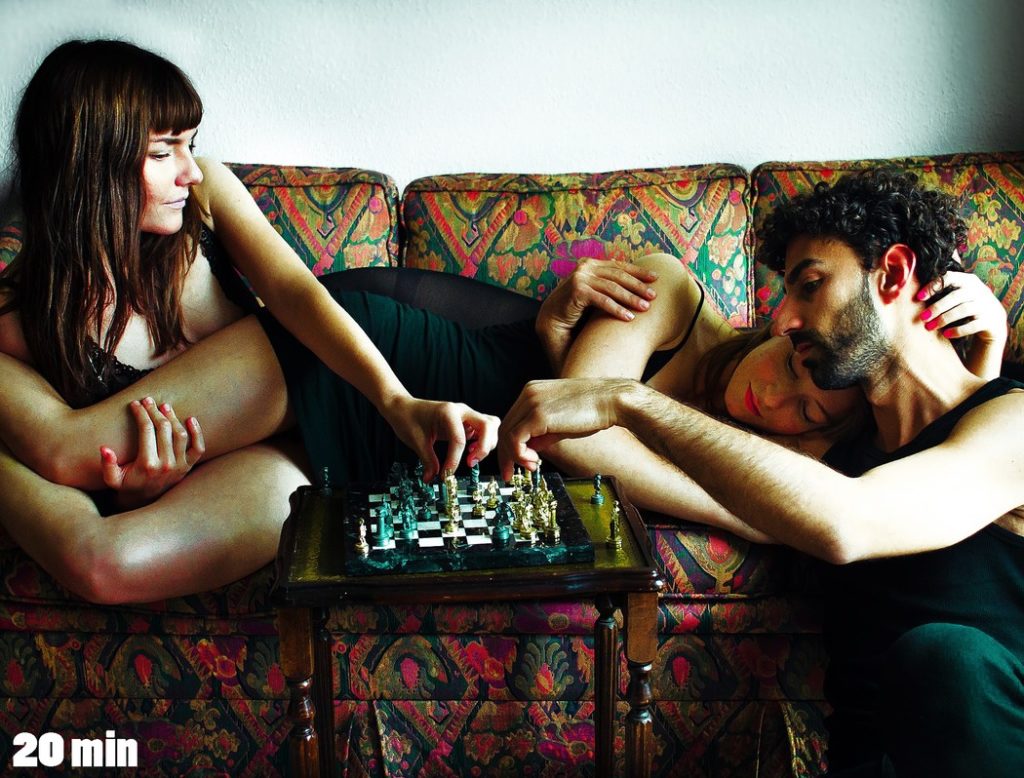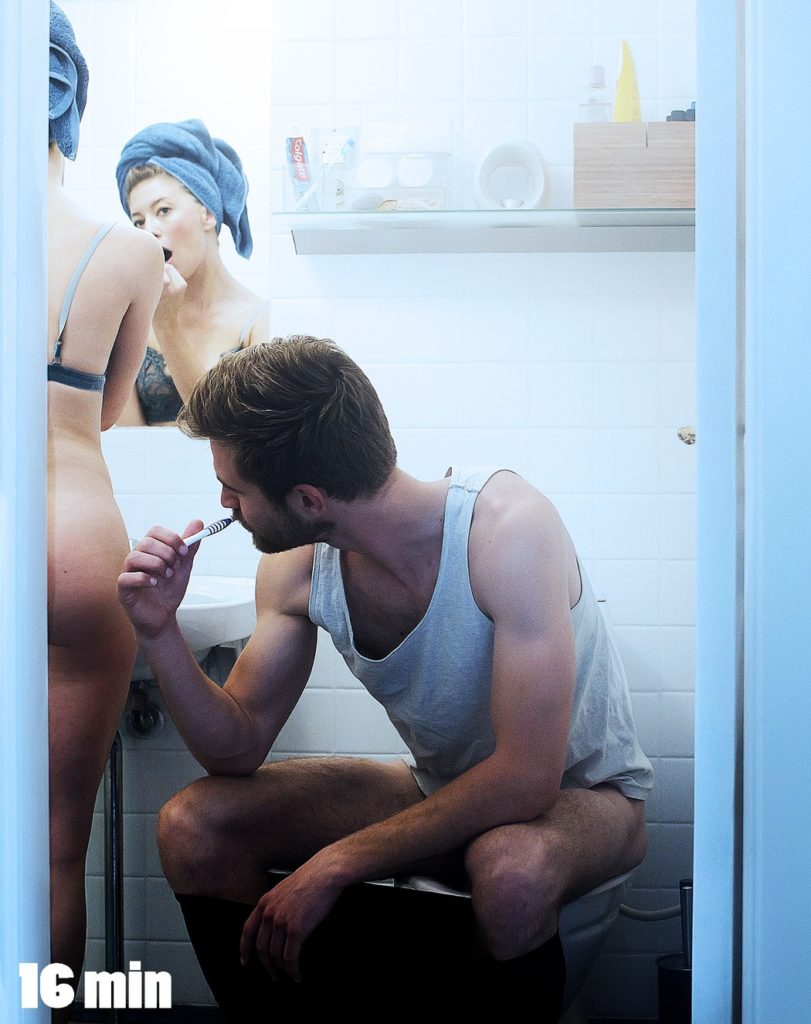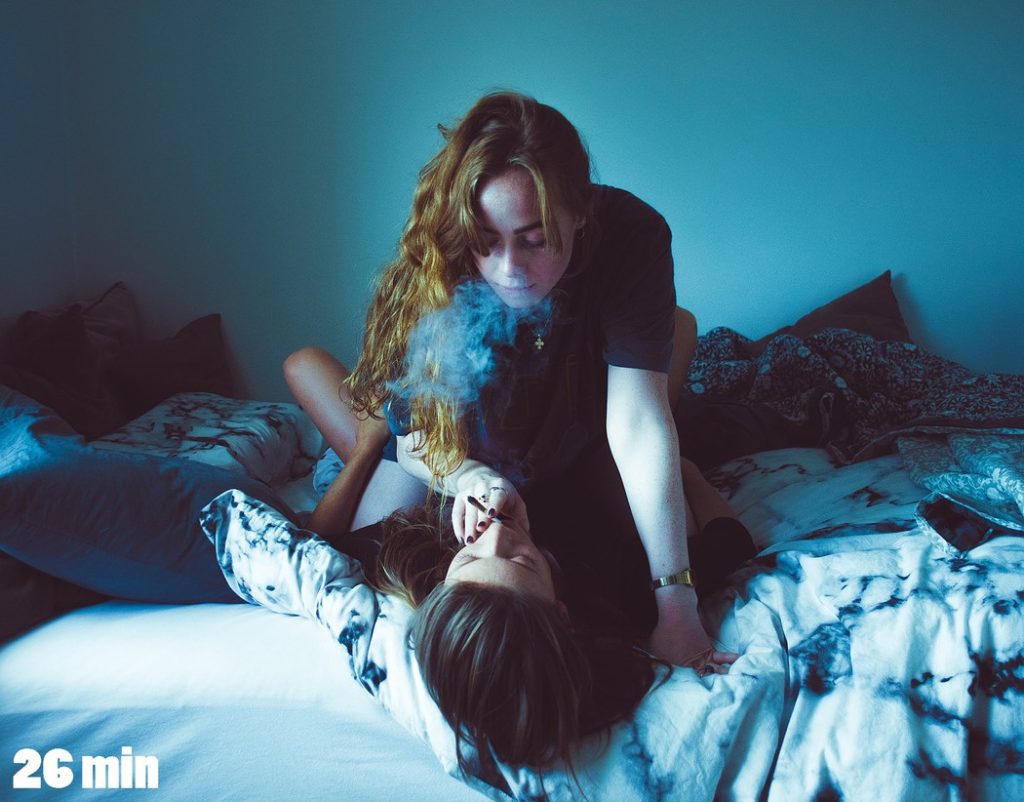My friend sent me an article about a young Danish photographer, Marie Hyld, who takes photos of herself with strangers she meets on Tinder, attractive men and women approximately her own age. Each photograph is staged to look like a candid moment of intimacy caught within an established romantic relationship, and, as with many long-term relationships, reflect a range of shifting moods: sexy, playful, sleepy, bored. At first, I was drawn to one of the sexy ones—Hyld and her partner standing in a green-tiled shower, embracing under the spray. Although the man’s face was partially concealed by Hyld’s head, her cheek pressed into the curve of his neck, from what I could discern of his profile and body, he so closely resembled a former lover of mine that for a few minutes I was nearly certain it was him. That man was an aesthete; he was handsome and vain and seemed to love feeling desired but avoided attachments. It was not difficult to imagine him volunteering for a project like Hyld’s, an artistic inquiry into make-believe intimacy. (This was before I learned that the photographer finds her collaborators in Denmark, a place I’ve never been) The resemblance also probably had to do with the photograph being staged in the shower. The man I knew would get up in the morning and take lengthy, luxuriant showers while I lay in bed, showers that went on so long I’d sometimes wonder if he’d passed out or left the building with the water still running. Invariably, I’d grow bored and climb out of bed to wander through his rooms taking inventory of his things: his books and paintings, his soft dark sweaters folded on the shelf, his pile of boots behind the bedroom door, his stacks of mail and his blender and the bowl of tangerines on the kitchen counter. I never touched anything, except once his phone, to check what time it was and also to see if other women had called him in the night. But mostly to check the time. I would’ve liked to shower with him but he never invited me and I was too shy to ask. I thought it might be time and space he needed for himself. I’d picture him in there, raking his fingers through his wet hair with his eyes closed as steam lifted off his skin. I wondered if he ever thought of me while he was in the shower—the woman he’d left in bed, now creeping around his apartment in her underwear. Maybe he did, maybe he didn’t.
I like Hyld’s pictures best when they capture moments of absolute banality. My favorite in the series is a shot framed by a bathroom’s pale blue doorway. Inside the room, photographer and a different man are brushing their teeth. She’s standing at the sink with her back to the camera, naked except for a towel wrapped like a turban around her hair and a lacy bra. He’s sitting on the toilet next to her in a light gray undershirt, pants around his ankles, elbows propped on his knees. His lips pursed are around his toothbrush; he looks like he’s about to make some garbled comment to her through the foam of toothpaste. And she, mouth open, eyes fixed on her own reflection in the mirror, eyebrows slightly raised, looks like she knows exactly what he’s going to say, like anything they could possibly say to each other they’ve already said a thousand times before.
There’s a timestamp in the bottom left corner of each photograph in the series. Hyld explains that the timestamps reveal exactly how much time has elapsed between meeting her subject for the first time and taking the photograph in question. They range from ten to thirty-five minutes. The timestamp on the tooth-brushing picture reads 16 min.
I found Hyld’s Instagram account and read about how she’d made the image:
He opened the door at the end of the hall and smiled at me…. We spent 1-2 minutes giggling like two schoolgirls and then quickly fell into the whole relationship scene. ‘God damn it, didn’t I tell you to turn around the toilet paper roll?! You’re making me so fucking old and bitter.’ ‘Shut up! You’re tiring me with all your negative shit, I can’t stand you!’ we yelled across the apartment while I peed with an open door and he brought me some water. It was hilarious. I felt so alive.
In the opening pages of Camera Lucida, critic Roland Barthes asks: What does my body know of Photography? The text that follows tracks his attempt to approach an answer. At the moment of reaching the essence of Photography in general, I branched off, Barthes writes. Instead of following the path of formal ontology (of a Logic), I stopped, keeping with me, like a treasure, my desire or my grief.
I love Barthes for his insistence that feelings can be marshaled as tools of intellect, that we might rely on these—my desire or my grief—as readily as anything else to make sense of art or the world. Barthes says he wants to think about photography as a wound, not in the sense that it causes hurt necessarily, but that it gets under the skin, it affects you at the molecular level, it leaves a trace. Lead by his desire or grief, he distinguishes the images that provoke his general interest (those characterized by what he calls the studium: that very wide field of unconcerned desire, of various interest, of inconsequential taste) from the photographs he loves: the ones that contain an element which rises from the scene, shoots out of it like an arrow, and pierces me. He calls this element the punctum: that accident which pricks me (but also bruises me, is poignant to me).
On her website, Marie Hyld wrote: To get under the skin of people. It’s my drive in photography—to hit. Maybe she’d read Barthes, maybe she hadn’t. In any case, I located the punctum in the photograph of the tooth-brushing couple right away: It’s the twist in her bra strap, just above the clasp. However lightning-like it may be, the punctum has, more or less potentially, the power of expansion, Barthes writes. While remaining a ‘detail,’ it fills the whole picture. In an image that’s been carefully composed to reflect the bodily intimacy of a long-term relationship—she’s bare-assed, he’s taking a shit—the twisted bra strap strikes me as unintentional—that accident which pricks me. It’s the realest thing in the scene, the detail that radiates out to make the whole picture feel real.
It’s not real, I know. The couple isn’t a couple, just two strangers who met for the first time sixteen minutes ago. But I think of Marie Hyld describing how she felt setting up the photo: so alive. How long does it take to forge intimacy that’s authentic? Does it have to last to matter? If you capture it on film, can you hold onto it longer? For a while when I was newly single and first getting used to the notion of sleeping around, I had this idea to take photographs of all the people I woke up with. Not in any formal way, not with their knowledge or consent—just sneaky shots of their backs as they lay facing away from me in bed. It would be my own private accounting. But it was tricky to execute: I’d have to use the camera on my phone, and my phone was often dead, or in another room, or in reaching for it I’d wake the person sleeping beside me; they’d roll over to face me and I’d miss my shot. I think I only ended up taking two of these photos, and they were both bad: blurred, indeterminate, the light and angles all wrong. You could hardly tell what you were looking at if I showed you, which I wouldn’t, because they were only for me. I wanted some kind of souvenir from all of the people who’d moved their bodies alongside or inside my body, who’d held me like they loved me, or at the very least like they desired to know me. (Barthes again: The Photograph does not necessarily say what is no longer, but only and for certain what has been.) If I’d given them timestamps they might’ve read: 3 hr 21 min; 7 hr; 4 mo, 1 wk, 5 days. With few exceptions I always felt there was at least a moment during these encounters when we revealed our real selves to one another, or close to it—an unguarded expression moving across the face, a dusty family photograph knocked over and then set carefully back in place, a fingertip tracing the line of the jaw, a chipped mug of water offered like a gift. Sometimes there was nothing to see. Sometimes it was just a sound. Maybe we’d never know anything more about each other; still, here we were together in this moment, so alive. Whenever I’d wake up to find the other person still sleeping, I’d feel as though they’d given me something—their body stripped of artifice, moving a little with their breath. I’d watch for as long as I could. That was enough; it had to be. It was all there was.
Ariel Lown Lewiton is a writer and editor in New York
from The Paris Review https://ift.tt/2rqAN6D




Comments
Post a Comment